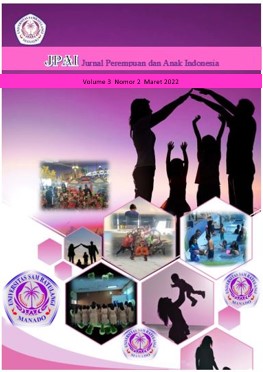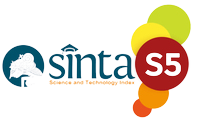PKM Ibu-Ibu PKK Desa Palaes Minahasa Utara Untuk Pemanfaatan Daun atau Bunga Mangrove sebagai Minuman Fungsional
Abstract
Palaes Village has a PKK Village management organization which consists of women or the wives of village administrators. Empowerment of the wives of village administrators and PKK is very necessary and urgent in supporting the development of Palaes Village to become a holistic Tourism Village Pilot Village. As a supporting tool and preparation towards this goal, women's empowerment is very much needed. This women's empowerment program is carried out in stages. In 2022, the introduction of mangrove plants, especially the flowers, is very attractive to be used as a functional tea. The steps and processes are carried out in stages and will be delivered in the socialization stage. The problem of Palaes Village in achieving this goal is that there are lots of mangrove leaves and litter there that often pollute and disturb the beauty if allowed to fall. Therefore, use flowers or leaves that have fallen to be used as functional tea drinks so that the wives and women of Palaes Village have work and creativity to be used as a means of developing tourism in their village later in the following year. Standardized product quality needs a good process so that the content of antioxidants and other important substances is good and the storage period is good. The stages that will be carried out are conveyed at the stage of socialization and introduction of the benefits of mangrove plants in this activity. The purpose of this program is to increase understanding of the use of mangrove flowers and leaf litter to be used as functional drinks, and understanding and skills on how to make good raw materials for flowers or mangrove leaves to be used as BPOM standardized functional drinks. The final goal is the empowerment of PKK women in Palaes Village to manage mangrove plants into functional drinks that will be traded in the future at Palaes Tourism Village. The specific target and objective of this activity is the process of making good simplicia with the introduction of the drying process and the BPOM standard and the form of natural tea products in the following year that are ready to use which are marketed online or on the website. The implementation methods that will be applied to this program are counseling, training, mentoring and evaluation of aspects that increase the ability of PKK mothers to earn additional income and achieve cleanliness and beauty problems. The output of this program includes dry simplicia whose quality is known. and leaning that is ready to be implemented in 2024.References
Afriansyah, S., Sindi Tira, B., & Nur Khasanah, A. (2020). “PEARL TEA†INOVASI TEH HERBAL BUAH MANGROVE PEDADA (Sonneratia caseolaris) SEBAGAI SUMBER ANTIOKSIDAN DALAM MENDUKUNG TERCAPAINYA INDUSTRI KREATIF 4.0 DAERAH JAMBI. Jurnal Khazanah Intelektual, 3(3), 527–542. https://doi.org/10.37250/newkiki.v3i3.43
Baderan, D. W., Utina, R., & Lapolo, N. (2018). Vegetation structure, species diversity, and mangrove zonation patterns in the Tanjung Panjang Nature Reserve Area, Gorontalo, Indonesia. International Journal of Applied Biology, 2(2), 1–12. https://doi.org/10.20956/ijab.v2i2.5752
Handayani, S. (2018). Identifikasi Jenis Tanaman Mangrove Sebagai Bahan Pangan Alternatif Di Kabupaten Sidoarjo Jawa Timur. Jurnal Teknologi Pangan, 12(2). https://doi.org/10.33005/jtp.v12i2.1287
Jumarniati, J., Baharuddin, M. R., & Hisani, W. (2020). Pkm Kelompok Petani Kelapa Bone-Bone Kabupaten. JMM (Jurnal Masyarakat Mandiri), 4(4), 6–9.
Lanamana, W., Dominicus, L., Djou, G., Fowo, K. Y., & Pande, Y. (2021). Peningkatan kemampuan wirausaha dan pelatihan pengolahan ubikayu nuabosi bagi anggota pkk. 5(6), 4–12.
Lubis, N., & Mutia, H. (2018). Pengabdian Masyarakat Pemanfaatan Daun Sukun (Artocarpus altilis) sebagai Minuman Kesehatan di Kelurahan Tanjung Selamat-Kotamadya Medan. Journal of Animal Science and Agronomy Panca Budi, 3(1), 18–21.
Pandiangan, D., & Nainggolan, N. (2021). PKM Pemberdayaan Perempuan di UMKM Biovina Herbal untuk Perbaikan Pengeringan Bahan Baku Herbal Standar BPOM. JPAI: Jurnal Perempuan Dan Anak Indonesia, 3(1), 22. https://doi.org/10.35801/jpai.3.1.2021.36745
Pandiangan, D., Nainggolan, N., & Maliangkay, H. P. (2021). Program Kemitraan Masyarakat untuk Perbaikan Proses Pengeringan Bahan Baku Obat Tradisional Pencegahan Covid-19 dan Perbaikan Produk UMKM Biovina. VIVABIO: Jurnal Pengabdian Multidisiplin, 3(3), 25–31. https://ejournal.unsrat.ac.id/index.php/vivabio/article/view/36793/34206
Priyono et al. (2010). Beragam Produk Olahan Berbahan Dasar mangrove.
Purnobasuki, H. (2004). Potensi Mangrove Sebagai Tanaman Obat (Prospect of Mangrove as Herbal Medicine). Biota, IX (2), 125–126.
Pursetyo.K.T, Tjahjaningsih.W, A. . (2013). Analisis Potensi Sonneratia Sp. di Wilayah Pesisir Pantai Timur Surabaya Melalui Pendekatan Ekologi dan Sosial-Ekonomi. Jurnal Ilmiah Perikanan Dan Kelautan, 5(2), 129–137.
Rangasamy, V., Kumaravel, S., & Ranganathan, R. (2019). Therapeutic and Traditional Uses of Mangrove Plants. Journal of Drug Delivery and Therapeutics, 9, 849–854. https://doi.org/10.22270/jddt.v9i4-s.3457
Saleh, A., & Kunoli, F. J. (2019). Pengaruh Penyuluhan Dan Pelatihan Melalui Media Leaflet Terhadap Pengetahuan Kader Phbs Di Kecamatan Ratolindo Kabupaten Tojo Una-Una. PROMOTIF: Jurnal Kesehatan Masyarakat, 8(2), 159–164. https://doi.org/10.31934/promotif.v8i2.498
Sugiarto Sentoso, M., Christy Ardi, A., Ayu Rahmasari, N., Artha Millenia, R., Arnold Christian Bangun, J., Diska Puspasari, A., Putri Ninda Budi, N., Wangsa Putra, R., Widi Jovenski, T., Dampi, A., & Kristianto, I. I. (2021). Pemanfaatan Buah Mangrove menjadi Olahan Makanan/Minuman di Desa Jangkaran, Kulon Progo. Jurnal Atma Inovasia, 1(1), 20–25. https://doi.org/10.24002/JAI.V1I1.3926
Wibowo, C., Kusmana, C., Suryani, A., & Hartati, Y. (2009). PEMANFAATAN POHON MANGROVE API-API (Avicennia spp.) SEBAGAI BAHAN PANGAN DAN OBAT. Prosiding Seminar Hasil-Hasil Penelitian IPB 2009, 158. https://lppm.ipb.ac.id/wp-content/uploads/2015/08/cahyo_dkk_158-159.pdf





